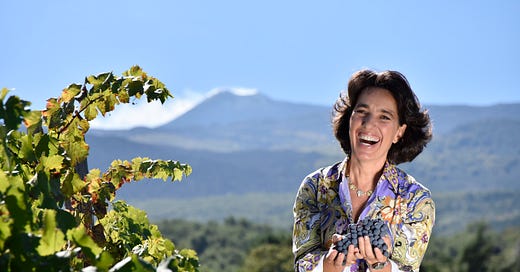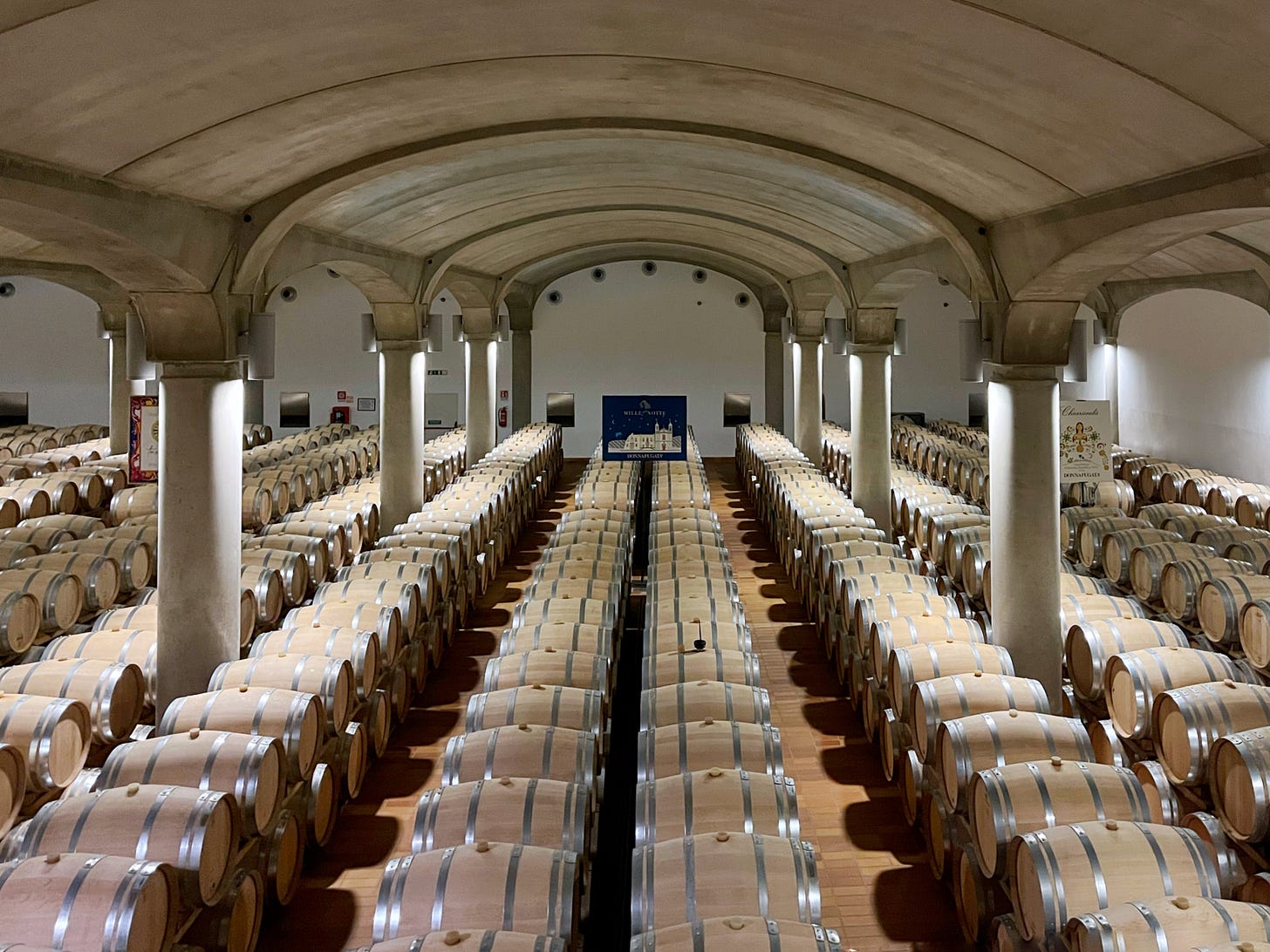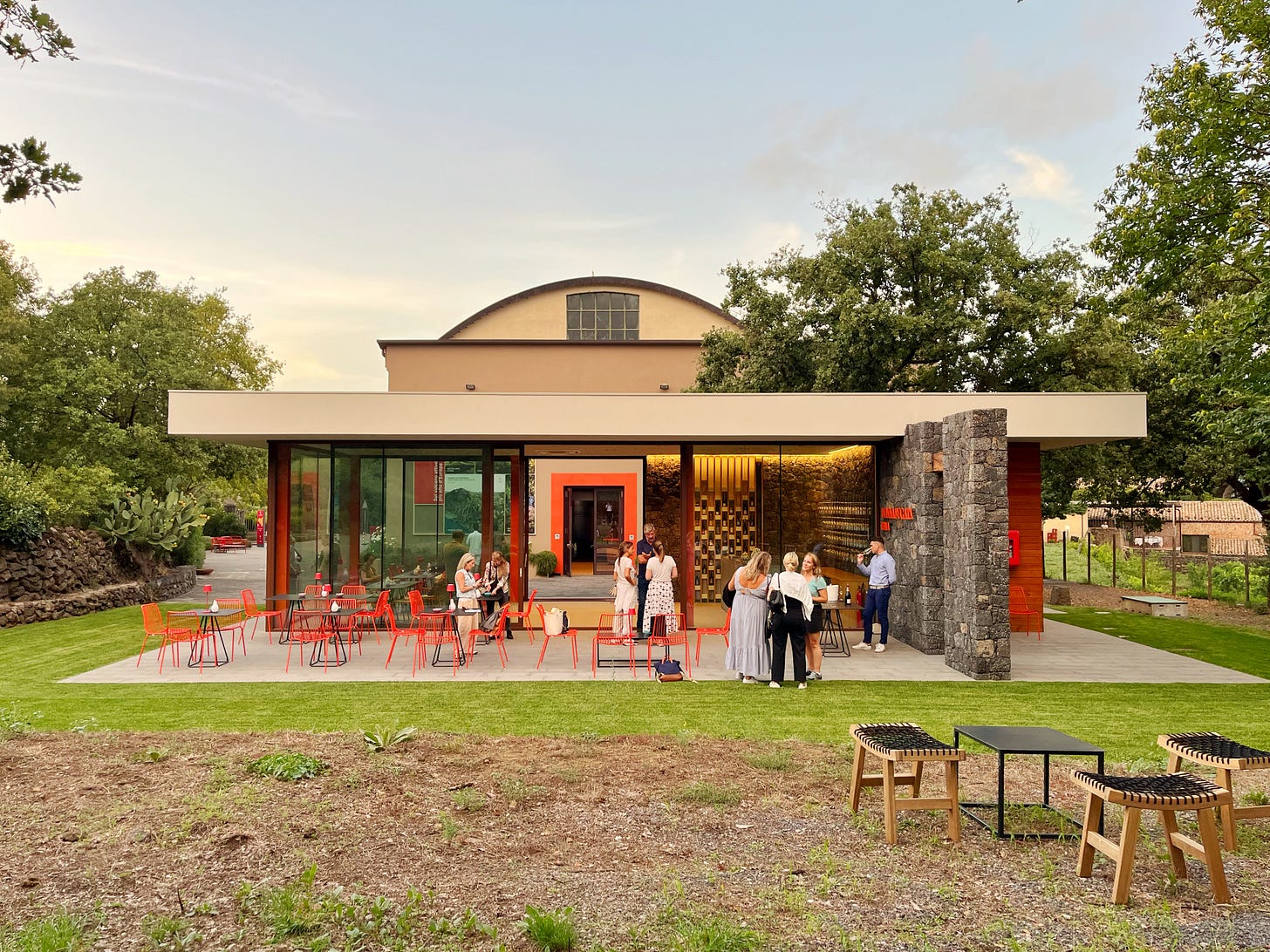Sicilian wine is having a moment and Donnafugata is here for it. Gone are the days when Sicilian farmers planted only international grape varieties, produced cheap table wine, or shipped their grapes in bulk to northern Italy to be blended with other more prized varieties. Sicilian varieties like Grillo, Catarratto, Nero d’Avola, Nerello Mascalese, and Zibibbo are increasingly appreciated for their own unique characteristics.
Donnafugata has been producing superlative wines with Sicilian varieties for over forty years. Giacomo Rallo and his wife Gabriella, who both came from winemaking families, founded Donnafugata in 1983 and have since passed the baton to their children, José and Antonio Rallo, who are now co-CEOs of the company. From the original vineyard in Marsala, Donnafugata has expanded across the island, with estates in Contessa Entellina, Pantelleria, Vittoria, and Etna. Their wines have won awards and they’ve collaborated with Dolce & Gabbana.
I had a chance to meet José, Antonio, and José’s daughter, Gabriella Favara, a couple of months ago on a press trip to Sicily and was inspired by their passion for winemaking and dedication to wine tourism in Sicily. As part of my series of interviews with creatives and entrepreneurs in Italy, I’m thrilled to share my interview with José Rallo, an inspiring female entrepreneur and talented singer who created Donnafugata Music & Wine and serves on the boards of Assovini Sicilia, ITA (the Italian Trade Agency) and FAI (the Fondo Ambiente Italiano).
Can you tell me a bit about how Donnafugata came to be?
Donnafugata is a story that goes way back. My father is the fourth generation of a family working in the world of quality wine. In 1983, he decided to launch a new brand together with my mother. He had experience in marketing and commerce and already knew the world thanks to the family business. He married my mom, who inherited this beautiful farm in the heart of western Sicily, and after ten years of experimenting, they joined forces and founded a winery with the goal of revolutionizing the style of Sicilian wine and they called it Donnafugata.
The name was a problem. My mom says she found this name in The Leopard, which for her in that moment was the book that put Sicily in a good position in Italian literature and film. My father was a bit concerned that the name was too long. “Would they understand it abroad?”
“Come on, Giacomo, don’t worry, trust me. I’ll draw the logo and show you this woman with long hair blowing in the wind.” She’s a woman escaping. And today we can say that this woman was my mother. Gabriella, who inherited a farm, abandoned her job as an English teacher and became a vintner. And certainly in Sicily, but also in Italy, there weren’t many women who ran wineries, so she was very special.
Donnafugata was created by your parents, but what was the family winery before that?
In 1851 the Rallo Winery was born in Marsala in a fortified farm typical of the 19th century and we made Marsala wine, which was famous during that period. They were following the path set out by the English companies like Whitaker, Ingram, etc. My father was the fourth generation and was looking abroad because those were the markets worth developing, but he didn’t find the dynamism he was hoping for, so he closed Rallo Winery and opened Donnafugata, where he was able to put his experience to good use.
Before, were they only making Marsala wine? What was their vision?
No, he had already started making white and red table wine that he was able to sell in the U.S. His vision was above all quality, quality, quality. This had to come from controlling the grapes and the vineyard. And my mom was involved in this, so he believed in it. Then they needed quality also in the winery. So he went to California and learned about the technique of cold pressing and chilling the grapes before vinification. And this was a technological step that contributed to his vision in an important way.
Then there was also the question of marketing. In the ‘80s and ‘90s, Italian wines all had these sad white labels. My mom, who was a very colorful woman, said, “Giacomo, we have to smash everything. We have to put Sicilian colors on our labels.” And she called an amazing illustrator, who began to tell stories of fleeing women—one who flies, who closes her eyes, who thinks, who dreams, another mysterious-looking one. All these women began to appear on the labels of our wines. It was a very distinctive, feminine, fantastic vision.
So the vision was to revolutionize Sicilian wine and its place in the world with quality wine and poetic marketing. Donnafugata’s labels express Sicilian stories through their colors and shapes. Because our illustrator is a children’s book illustrator. So his work is to enter one’s heart through a few lines.
At the time, Italian wine’s reputation abroad was tied to Tuscany, no?
Yes, Chianti, Lambrusco. They hadn’t yet reached the quality that they later achieved. Eventually, Italian wine became wine in bottles, which it wasn’t originally. It became traceable, with better branding, so there was a lot to do in Italy, not only in Sicily.
I’m very interested in this story about the evolution of Sicilian wine. I have the impression that even within Italy, Sicilian wine was seen not as bad per se, but not the best. And now that’s changing.
I had a story that I told myself. I said, “Okay, Sicilian wine hasn’t reached the level of quality that it needed to, but in essence, precisely because we started a bit behind, we don’t have the shackles that others do.”
We were much freer. And when the first three winemakers joined forces and created this association, Assovini Sicilia—today there are 100 wineries across Sicily—we were able to exchange advice about best practices, marketing and communication. So in my opinion, in Sicily we were able to form a team before the other regions. Thanks to this, we made strides. We probably haven’t made a wine like Sassicaia yet, but today we’re competitive.
Who were those first three wineries?
Tasca d’Almerita, Planeta, and Corvo—and Florio, which was later bought. Diego Planeta brought the cooperative Settesoli into it, so it expanded. We tried to be very elastic as a team in order to achieve our goals.
We’re talking about which period exactly?
The ‘90s. The Association Assovini Sicilia just celebrated 25 years.
Back then, did the Sicilia DOC exist?
Not yet. Because Sicilia DOC came after Assovini. That was a sort of training ground where we all took on tasks, we trained ourselves and formed a team. Then we needed a marketing instrument. The DOC is a marketing instrument because with one word you involve all the investments.
Then after five, eight years, all the small DOCs and subzones will emerge. That’s doable, the law allows it. Sicily made progress because there are 150 producers, who do publicity, then the distributors arrive, they talk about the Sicilia DOC. It all works together.
And when did you get involved with Donnafugata?
In 1983, I started university. After I graduated, I worked for two years in a multinational consulting company and I entered the company in 1990. I decided to marry a Sicilian. So I called Giacomo, my father, and said, “Can I come work for Donnafugata?”
And he said, “Of course, Jo, the doors are always open for you, but you know you have to start at the bottom and then grow. I’ll give you jobs that let you grow, but since I have faith in you, you’ll become responsible for the projects you want to develop in the winery.”
I was interested in computerizing everything and management control as well as marketing and communication. But in his view, I had to start with simple things in order to learn about the company and so the other people could get to know me. Some of them were there since the beginning.
So it wasn’t a sure thing that you would work there?
No, not at all.
When you were little, you didn’t think about it?
No, I always had my suitcase ready. I won a scholarship at 19 years old for one of the best Italian universities, so I got my degree there and immediately found a job. I needed to be independent.
And when you started at Donnafugata, did the company already have five estates?
No, when I started there was the historic winery in Marsala, there was Contessa Entellina, where Donnafugata’s wines were effectively born, and there was Pantelleria, where we arrived in 1989.
So the company has grown a lot since you started.
It has grown a lot. We had difficult moments, like the financial crisis, when we had to make important decisions and bring in external consultants to help us navigate these hard times. A company always has to be open to collaborations and contributions from specialists because we can’t know everything.
We know how to make wine, beautiful labels and packaging, but we can’t know everything about what to do in a global financial crisis the likes of which no one has experienced before. And my desire to bring in contributions from outside the family continues. When my father died, the president of our board of directors became someone outside the family.
And what about the decision to open up the wineries to visitors?
That was a very beautiful moment for me. In the ‘90s, the movement of wine tourism was born and I said, we have to jump onboard. “But how will we do it, Jo? Here are the pumps, the machines, the tubes. We can’t bring people inside the winery.”
The first time I brought a group of people to visit the winery, they asked me to tell them a month in advance so they could tidy up. The second time they asked for two weeks notice. The third time, they asked for three days. The next time, it was in real time. This allowed the production, communication and marketing to work together. I think this is fundamental in order to communicate internally in the company.
It must be nice also for the people who visit.
What I see is that the people who come here visit the winery because they want to discover a secret. They ask lots of questions, just like you. And they try to discover a secret that only they know about Donnafugata. They’re fans. It’s extraordinary. You create an excellent rapport. Then they leave with a bottle or two and this love for the company. They like the winery and feel welcomed by the people here.
It gives another feeling to the wine. After you visit the winery and then you drink the wine, you have a different feeling.
We opened the winery in 1994, when I was becoming a mother, and this was also tied to wanting to be with my children in the first months. I liked the idea of doing wine tourism, being welcoming, being a bit of a mom with the fans. Now it has grown and evolved a lot. We’re talking about 30 years. Today we offer food and wine pairings, revisited recipes from the Sicilian tradition. There are new things.
Has the type of visitor changed?
I think the average age is decreasing. We can teach about why moderate consumption is important. We taste, we talk, we drink—not just drink. And I think that people who follow this passion for wine tourism already have an appreciation for wine. If all wineries encouraged moderate consumption, we would be better off. Italy knows this, Italians consume wine in this way.
For visitors who come and want to see a bit of Sicily, what do you suggest?
Marsala has a very interesting destination: the salt pans, where they collect salt from the sea. Sea salt has properties that have nothing to do with table salt. It contains less potassium and other minerals. Then it has a much bigger capacity to salt things, so you can put very little sea salt and it gives a lot of flavor. So it’s a product that’s much better for you. The salt pans are incredible.
Also the Egadi Islands are beautiful. You can take walks, go swimming, diving. You can see archeological ruins. In the little island of Levanzo you can go to the archaeological park where you can see ruins of Roman boats that sank during a battle. In Favignana there’s an old tuna processing factory from the 1800s by Florio. They didn’t waste any part of the tuna. They used the fishbones to make soap. Talk about a circular economy!
Then in Pantelleria there’s so much to see. On Etna there are incredible things to see. There are the woods and canyons. Etna is very active. There’s a canyon with this icy water, maybe it comes from the volcano, which reaches 3,300 meters. Sicily is so rich.
Where do you live?
I live here in Marsala near the salt pans.
Aside from the salt pans, are there any hidden gems in Marsala?
We have this wooden boat that dates back to the Phoenician era. And inside this boat they found a bunch of interesting things, like part of an olive tree, so we understand that the Phoenicians cultivated olive trees and made oil. They found pieces of red textiles, so they understood that they colored textiles.
Then they found a nail that wasn't rusted, so they thought it was made from a very unusual mixture of metals. The archeologist even said who knows, maybe if we discover how this mixture was made we can use it to contain nuclear refuse. There’s an archeological museum of the city, which was also an important city in the Roman Empire. There are beautiful floors.
Is there anything you wish people understood about Sicily or Sicilian wine?
Sicily is an island in the Mediterranean with incredible facets, from the volcanic islands to the sandy beaches. The gastronomy is also a mix, from the Arab culture to the French and Spanish influences. So I say: Come to Sicily with a spirit of adventure and you will find many things that will surprise you and remain in your heart.
Further Reading
You can learn more about Donnafugata and book a visit to one of the wineries here.
Want to learn more about herotic viticulture in Pantelleria and the incredible Passito di Pantelleria that Donnafugata makes there? Check out my latest article for Food & Wine.
Curious about what else there is to do on Italy’s largest island? For AFAR, I wrote about where to go in Sicily if you liked ‘The White Lotus’.












Wine tasting on the Circumetnea train was as unforgettable as the journey
Italian creatives of this generation are such a great blend of traditional artigiano/a, innovative, sophisticated entrepreneur and cultural ambassador. Really enjoy these features!